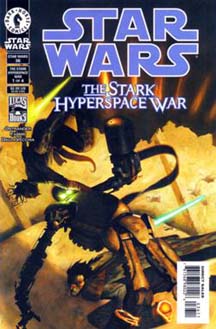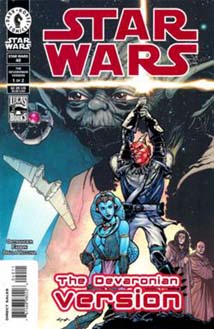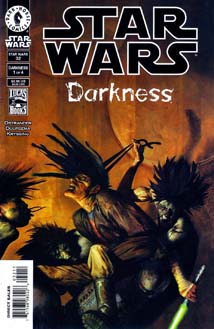Issue 32 of “Star Wars: Republic” marks the start of John Ostrander’s epic run as the primary writer of this ongoing series. Starting here, he writes 19 straight issues, taking the series up to the start of the Clone Wars, then he’ll continue to be the main writer throughout that epic saga-within-a-saga. All told, he’ll write 40 of the final 51 issues of “Republic,” a prolific feat not even Marvel regulars Archie Goodwin, David Michelinie and Jo Duffy could touch.
“Twilight” (Issues 19-22) put Ostrander on the map, and this next batch solidifies his spot on the short list of best “Star Wars” comic writers. “Darkness” (Issues 32-35) is the next chapter in the story of amnesiacs Quinlan Vos and Aayla Secura. Quinlan made strides in “Twilight,” but Aayla not so much – she not only hates her Jedi Master’s guts for killing her uncle Pol Secura, but she demonstrates her loathing by reviving a dark sider from suspended animation on the prison world of Kiffex and serving as his apprentice. Similar to Tim Truman, “Republic’s” previous shepherd, Ostrander expands on established lore in creative ways. Volfe Karrko is an Anzati ex-Jedi who commands an army of feral Anzati that are sort of like the Turok-Han vampires in Season 7 of “Buffy.”
Aayla rediscovers her inner goodness when Quinlan says in Issue 35, “If only my blood will quench your anger, Aayla, then strike. I will not stop you.” It’s basically the same way Xander pulls Willow back from the dark side in Season 6 of “Buffy,” and it has me looking forward to future Aayla adventures now that she’s good again. It’s also cool to meet Quinlan’s Master Tholme.
“Darkness” also smoothes over a potential continuity flub: In “Jedi Council: Acts of War,” Villie is the Jedis’ enemy, but in “Infinity’s End,” Mace Windu works with Villie. Quinlan found out about Villie’s alleged anti-Jedi actions in the meantime, and beats the crap out of the Devaronian when they reunite here.

“The Stark Hyperspace War” (36-39) is a classic example of an arc that’s hard to follow when each issue is read one month apart, fresh off the newsstands, yet comes together beautifully when read in one sitting. It’s ambitious, almost too ambitious, as Ostrander has the major players of the pre-“Episode I” Stark Hyperspace War recount the events to Aayla, who is re-adjusting to life in the Temple.
A political/war tale that’s superior to both “Jedi Council: Acts of War” and “The Phantom Menace,” “The Stark Hyperspace War” lines up two sides in a trade dispute – essentially Outer Rim vs. Inner Planets, with dishonest brokers on both sides. While Stark leads a villainous cadre of disgruntled traders, Ranulph Tarkin (not to be confused with future Grand Moff Wilhuff Tarkin) attempts to form a Republic Army without Senate approval. The noble Finis Valorum and the weaselly Neimoidian Nute Gunray are also in the mix for the de-facto good guys. The story includes Qui-Gon and a teenage Obi-Wan (marking “Republic’s” first significant use of main movie characters) and Tholme and a teenage Quinlan in supporting roles. And Plo Koon — who has the ability to communicate telepathically (continuing “Republic’s controversial idea of giving Jedi specific powers) — ends up as the hero of the piece.


Apparently hooked on the “storyteller” approach, Ostrander uses that method again in the comedic “Devaronian Version” (40-41), which further explores how the Villie was a pawn more so than a big bad in “Acts of War.” Kilian Plunkett and Dan Jackson’s cover of Issue 40 is a gem, as it reimagines the “A New Hope” poster with Villie in the heroic Luke pose and Aayla (who is not in the actual story, but a “yum-yum” was needed to round out the image) in the guise of Leia.
We already suspected that Villie sees himself as the hero of every story, but “The Devaronian Version” takes this to humorous extremes – like when we see that Homer Simpson pictures himself as broad-shouldered and muscular. The Devaronian recounts the events of “Acts of War” to a table of cantina denizens, drawing upon his self-centered and ale-addled memories. The level of ridiculousness is gradually ratcheted up so that by Issue 41, the Jedi Council is fighting amongst themselves, with Yoda biting Plo Koon’s leg like a rabid dog, and the story wraps up tidily when Villie’s pet monster eats Darth Sidious in a single bite.
Comedic “Star Wars” tales are difficult to get right, and I wouldn’t want every “Star Wars” comic to be in the tone of “The Devaronian Version.” But I’ll accept this two-parter because it stays true to Villie’s character while often being hilarious.

